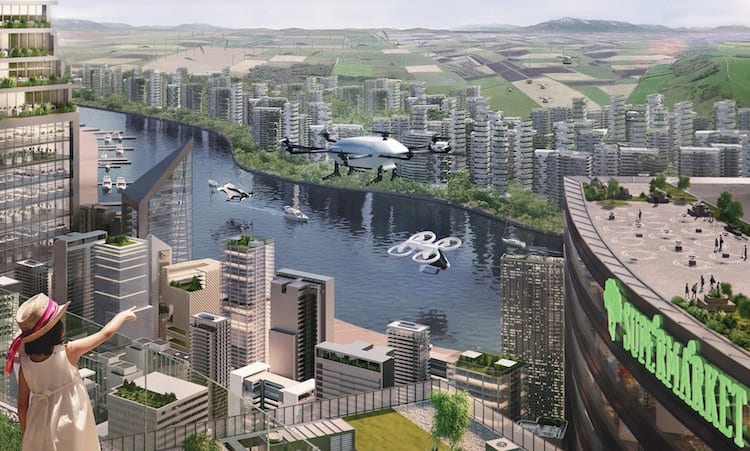
Urban air mobility concept of operations. Photo: Airbus
Public perception of the proposed use of electric air taxis is most influenced by the noise generated and perceived safety of such vehicles, a new study has found.
The study, conducted by the new urban air mobility division of Airbus, surveyed 1,540 respondents in Los Angeles, Mexico City, New Zealand and Switzerland. Using Likert scale style questioning, the researchers found that respondents are more willing to embrace the use of UAM if operators can ensure the safety of individuals on the ground.
Fifty-five percent of respondents said safety was their primary concern influencing their willingness to use electric vertical takeoff and landing (eVTOL) aircraft. The second highest public perception factor was the type of noise generated by such vehicles, followed by the time of day and altitude at which eVTOLs are flown.
Isabel Del Pozo De Poza, head of airspace management for the unmanned traffic management division of Airbus, said the researchers started from a common reference point. They wanted commuters to give their perception of urban air mobility starting from the ground and looking up.
“We did day flights at 100 aircraft per hour, night flights at two aircraft per hour at high altitudes and low altitudes, the idea was to try to evaluate their emotional reaction to this type of new technology,” De Poza said. “One out of two people surveyed were really excited about it so we’re pretty excited about those statistics.”

A scenario respondents were asked about.
A major goal of the survey was to help transition Airbus from its traditional business-to-business model of manufacturing aircraft to the more consumer-facing style of operations it will need for electric air taxis. Eduardo Dominguez-Puerta, Airbus’ head of urban air mobility, recently told the AIAA SciTech forum he believes that by 2030 the UAM market will be worth an accumulated $50 billion, less than half of which will go to vehicle makers.
A total of 385 respondents were asked about the eVTOL operations in each of the four cities targeted as part of the study. Respondents in Mexico City were the most welcoming and expressed the highest likeliness to use eVTOLs, with 67 percent of respondents saying they were likely or very likely to use urban air mobility in the future.
Among the demographics surveyed, age and income were influential factors in determining respondents’ views of UAM as well. Among LA respondents for example, those making more than $150,000 annually had more positive reactions to the future use of UAM.
Across all four locations, respondents between the ages of 25 and 34 had the highest initial positive reaction to urban air mobility, with 55 percent of millennials responding positively.
The likelihood of respondents to use UAM in the future was also shaped by the length of their existing daily commute.
“We asked the typical commute of the respondent and then we used that against their willingness to take UAM, those with average commute of 25 minutes are more likely to use UAM than those with an average commute of 19 minutes,” De Poza said.
The study also observed the modes of transportation that people currently engage in, showing the strongest link between likeliness to use UAM and those who use rideshare services such as Uber. Perceived convenience was also highest in Mexico City and Los Angeles, which the researchers believe was influenced by the lower inner city traffic volumes found in New Zealand and Switzerland.
Overall, the researchers found that manufacturers and service providers will need to focus on noise and their ability to ensure the safety of people on the ground under the airways that eVTOLs will use in the future.
“We’ve done three demonstrations of UAM vehicles, to date and through each of these are demonstrators that we’ve learned a lot from in terms of performance and the type of vehicle that can be fielded,” De Poza said. “We have now done the research on public perception, and we feel like the next vehicle we build will be the one we go to market with.”